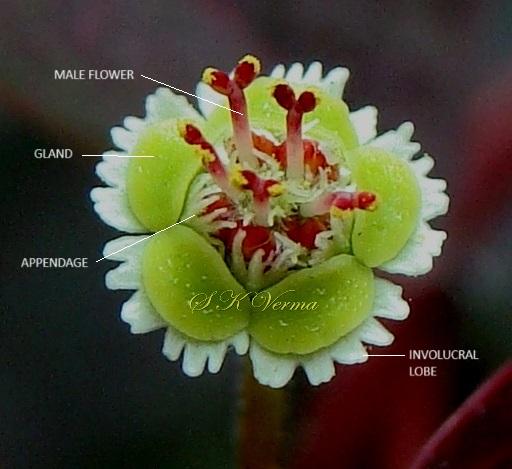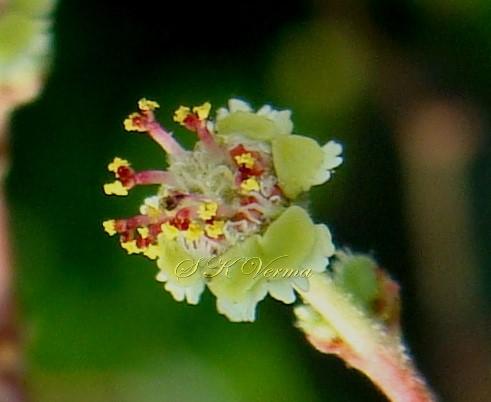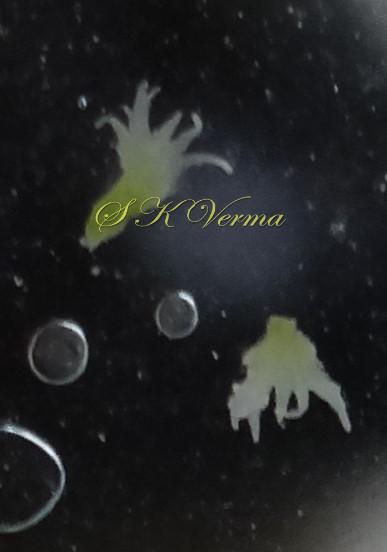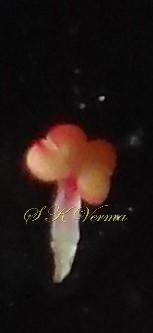EUPHORBIA
Euphorbia
L., Sp. Pl. 450. 1753; Gen. Pl. ed. 5: 208. 1754; Boiss. in DC., Prodr. 15(2): 7. 1862; Benth. & Hook. f., Gen. Pl. 3(1): 258. 1880; Hook. f., Fl. Brit. Ind. 5: 244. 1890; Parker, For. Fl. Punj. ed. 1: 445. 1918 (Reprint 1973); Radcliffe- Smith, Fl. Pak @ eFloras.org p. 88; Ma & Gilbert, Fl. China @ eFloras.org 11: 288.
Monoecious herbs, shrubs or trees, often succulent, all parts with milky latex, with a simple indumentum when present. Stems succulent, terete or variously winged or tuberculate. Leaves alternate or opposite, rarely verticellate; stipules present or not, sometimes modified into glands or prickles; petioles often ill-defined or absent; leaf blade usually entire, sometimes serrulate or dentate. Inflorescence is flower-like CYATHIUM, single or often many in terminal or axillary, dichasial or monochasial cymes often in a ‘pseudoumbel’ with a terminal +/- sessile cyathium subtended by a whorl of pedunculate cymes, each subtended by an involucral leaf. Cyathium consists of bowl-shaped to tubular involucre subtended by a pair of bracts “ cyathophylls” enclosing one central female and several clusters of male flowers, occasionally cyathia unisexual; involucre margin with 4 or 5 lobes, (1-) 4 or 5(-7) cyathial glands, mostly alternating with involucral lobes. Male flower reduced to a single stamen, with an articulation at junction of pedicel and filament, subtended by slender bracteoles. Female flower pedicellate, reduced to a single ovary, rarely subtended by a very reduced perianth, ovary 3-locular, ovules 1 per loculus, styles 3, free or connate at base, stigmas often bifid. Fruit a capsule separating elastically from a persistent axis into 3 two-valved cocci. Seeds often carunculate.
2073 species
Euphorbia cotinifolia
Euphorbia cotinifolia
L., Sp. Pl. 1: 453. 1753; Fl. China @ eFloras.org 11: 297; keralaplants.in
Dioecious shrub or small tree, 1-3 m tall; stem branched, branches spreading, dark red, glabrous. Leaves 3- whorled; petioles long, 2-9 cm long, more or less reddish, sparsely hairy; leaf blade ovate, 2-6 cm x 1-4 cm, both surfaces purple-red when young, pale green when mature (only lower leaves), base subtruncate, margin entire, apex obtuse, main vein prominent on both surfaces, lateral veins 6-12 pairs, both surfaces glabrous. Stipules absent. Inflorescence as small, few to many-branched cymes consisting of tiny cyathia. Cyathia terminal, dioecious (studied specimen male only) solitary on 1-2 cm long hairy peduncles, involucre broadly campanulate, hairy, ca 4 mm x 2.5-3 mm, lobes (4-) 5 (-6), broadly oblong, shallowly and obtusely lobed or laciniate, whitish; glands 4, ca. 2 mm across, transversely oblong, greenish-yellow; glands with appendages (or limb), appendages petaloid white or pale-yellow, deeply lobed or laciniate. Male Flowers: Numerous, reduced to solitary stamens; pedicels ca. 1.5 mm long; anthers subglobose, transversely dehiscing. Bracteoles setaceous, linear, laciniate, ca. 1.5 mm long.
Female Flowers: Solitary in involucre, exserted; involucral pedicel ca. 3 mm long, sparsely hairy. Ovary ca. 4 mm diameter, triangular with vertical furrows, glabrous; styles 3, each bifid from middle, ca. 1 mm long; stigma capitate. Capsule 3-angular- broadly ovoid, ca. 5 mm x 6 mm, smooth, glabrous. Seeds ovoid or subglobose, 2-3 mm in diameter, brown, pitted on surface and occasionally also warted, ecarunculate. (Female flowers and Fruits not observed. Description as per literature)
Common Names: Carribean Copper Plant, Chocolate Bush, Mexican Shrubby Spurge, Red Spurge, Smoke Tree Spurge, Tropical Smoke Bush

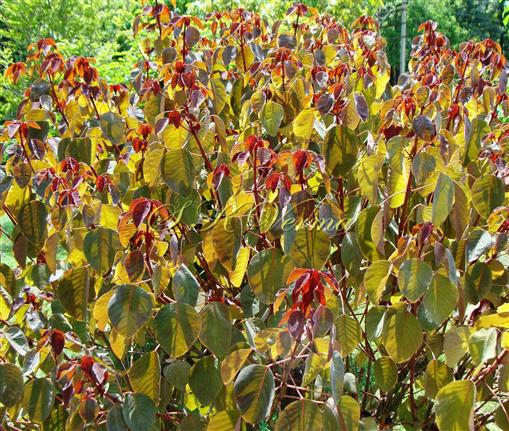
-DSC09624.jpg)
-DSC09623.jpg)

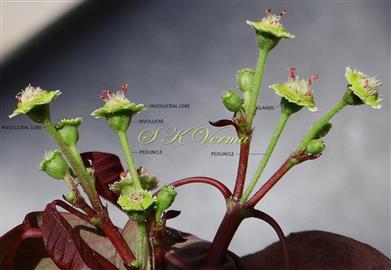
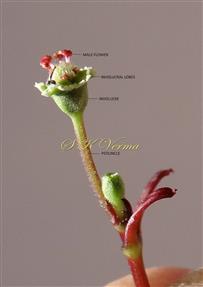








-DSC09624.jpg)
-DSC09623.jpg)



